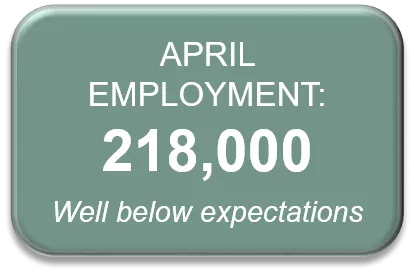May Economic Commentary: April employment report tempers expectations

Chief Economist
Pohlad Companies
Economic progress has been playing out as scripted by many economists. As in the best of stories, however, there is often an unanticipated twist that causes you to re-examine your assumptions about the path to the ultimate outcome. For the current economic recovery, that twist came last Friday with the release of the April employment report. Let’s set the stage leading up to that report and discuss how some expectations may have changed as a result.
Personal Income
Coming off the passage of the $1.9 trillion fiscal stimulus on March 11, March personal incomes posted their biggest monthly increase in history. Household savings ballooned to $4.5 trillion more than where they were pre-pandemic. Coupled with improving consumer confidence due to the ongoing surge in housing and equity prices, the result was the March retail sales report showing growth of 9.8% vs. expectations of 5.8%. It was the second-largest monthly gain in retail sales in the series’ history.
Inflation
Inflation readings have started to increase as year-over-year data make comparisons to the weak inflation environment at the beginning of the pandemic. This has been expected, but when added to the robust consumer demand being supported by the fiscal stimulus and strong commodity prices, concerns have surfaced about the Fed’s plan to remain accommodative through 2023. Although the Fed has historically started to increase interest rates when they see inflationary pressures building, this time is different they say. Even with inflation expectations at the highest level since 2013, the Fed has made it clear they are going to be patient in reacting. They view the expected increase in inflation over the next 6-12 months to be transitory. They will admittedly be behind the inflation curve when they finally do start tightening.
Much of the current inflation concern is related to the sharp increase in commodity prices since last summer, but longer-term inflation is more a result of persistent wage inflation, and until we are back near full employment, the Fed doesn’t see wage inflation developing. The concern about inflation has caused long-term interest rates to rise a full percentage point during the past year.
GDP
The first reading of real GDP in the first quarter was released showing 6.4% annualized growth. Second-quarter GDP is expected to be even stronger, which would surpass the all-time high in GDP recorded just prior to the pandemic. For the year 2021, GDP is estimated to be between 6% and 7%, making it the strongest yearly growth since 1984. The economy could probably grow faster, but supply constraints (both components and labor) will likely be a limiting factor.
Corporate profits have been improving. With 88% of S&P companies having reported for the first quarter, we’ve seen revenue growth of 12% and earnings rising by more than 40%, well above estimates.
Employment
With all of this as a backdrop, the April employment report was released on May 7. You might recall that the March employment report was exceptionally strong (+916,000), and April was expected to be even stronger with an increase in payrolls of 1,000,000. The actual number was 218,000, and the March report was revised down by 146,000. The unemployment rate rose slightly to 6.1%. There are still 9.8 million people categorized as unemployed, and another 6.6 million who want a job but weren’t actively looking in the past four weeks.
This weak labor report has changed expectations about the persistence of the early inflationary pressures we’ve been seeing and confirmed the Fed’s stance to remain patient, at least for a while. It’s worth mentioning that the Fed rarely, if ever, starts tightening before the job losses from the previous recession are recovered. The labor market still has a substantial way to go before it is back to pre-pandemic levels.
Finally, it is clear that the economy remains heavily dependent on fiscal stimulus to grow until employment levels recover more completely. While it is prudent to monitor the persistence of the current inflationary pressures, we should also be concerned about what will happen in the second half of the year as the impact of the recent stimulus package ebbs. Remember how economic activity slowed significantly in 4Q-2020 when stimulus programs expired.
Insights
Research to help you make knowledgeable investment decisions
